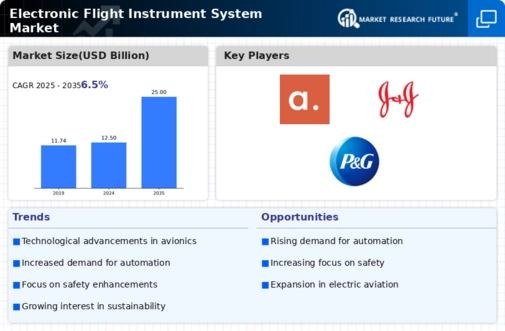The Electronic Flight Instrument System Market is characterized by a dynamic competitive landscape, driven by technological advancements and increasing demand for enhanced safety and efficiency in aviation. Key players such as Honeywell (US), Rockwell Collins (US), and Garmin (US) are at the forefront, each adopting distinct strategies to solidify their market positions. Honeywell (US) focuses on innovation, particularly in integrating advanced avionics with artificial intelligence, while Rockwell Collins (US) emphasizes strategic partnerships to enhance its product offerings. Garmin (US) is leveraging its expertise in consumer electronics to penetrate the commercial aviation sector, indicating a trend towards cross-industry collaboration that shapes the competitive environment.
The market structure appears moderately fragmented, with several players vying for market share. Companies are increasingly localizing manufacturing and optimizing supply chains to enhance operational efficiency. This trend is likely a response to the growing need for rapid delivery and customization of electronic flight instruments, which could potentially lead to a more competitive landscape as companies strive to meet diverse customer needs.
In August 2025, Honeywell (US) announced a partnership with a leading aerospace manufacturer to develop next-generation flight displays that incorporate augmented reality technology. This strategic move is significant as it positions Honeywell at the cutting edge of innovation, potentially redefining pilot interfaces and enhancing situational awareness in the cockpit. Such advancements may not only improve safety but also attract new customers seeking state-of-the-art solutions.
In September 2025, Rockwell Collins (US) unveiled a new suite of integrated flight management systems designed to optimize fuel efficiency and reduce operational costs for airlines. This initiative underscores Rockwell Collins' commitment to sustainability and operational excellence, aligning with industry trends that prioritize environmental responsibility. By focusing on fuel efficiency, the company is likely to enhance its competitive edge in a market increasingly driven by eco-consciousness.
In July 2025, Garmin (US) expanded its product line to include advanced electronic flight instrument systems tailored for small to mid-sized aircraft. This strategic expansion reflects Garmin's intent to capture a broader market segment, particularly as demand for general aviation continues to rise. By diversifying its offerings, Garmin may strengthen its market presence and appeal to a wider range of customers, from private pilots to commercial operators.
As of October 2025, the competitive trends in the Electronic Flight Instrument System Market are increasingly defined by digitalization, sustainability, and the integration of artificial intelligence. Strategic alliances are becoming more prevalent, as companies recognize the value of collaboration in driving innovation. The competitive differentiation is likely to evolve from traditional price-based competition towards a focus on technological advancements, reliability in supply chains, and the ability to deliver customized solutions that meet the specific needs of diverse aviation sectors.

















Leave a Comment